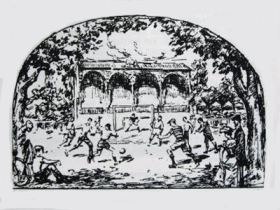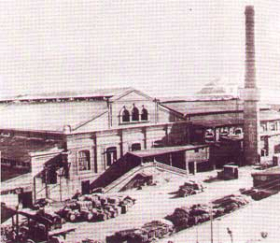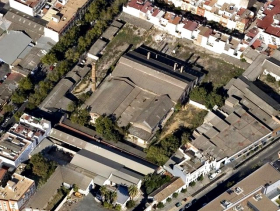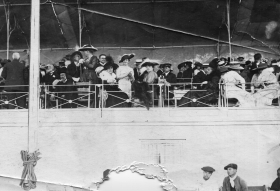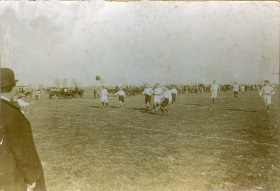Campos de juego de la historia
Between the gardens of San Telmo and the Venta de Eritaña, where the annual Selected Livestock Exhibition was held, the land known as the Huerto de la Mariana was located on the site now occupied by the Plaza de América.
In the autumn of 1905, the Sevilla FC Board of Directors requested this land from the Town Hall for the Society's sporting activities.
It is said that the pitch was not bad, but it had the disadvantage that inside the pitch there was a large tree that sometimes hindered play, but at other times it was used to make great wall passes between the players.
Sevilla FC played on this pitch until the autumn of 1908, when the grounds were occupied by the Real Tennis Club, and football moved to other areas closer to the Prado de San Sebastián.
Around 1900, Sevilla FC moved its home ground to the so-called La Trinidad pitch.
It was located in the Santisima Trinidad neighbourhood, on Avenida de Miraflores next to the old glass factory of La Trinidad, in the area known as Huerta San Francisco next to the Laguna de los Patos. The owner of the factory was Luis Rodríguez Caso and the manager was his brother-in-law Rafael Giménez de Aragónguada, who would later form part of the group of Sevillistas who registered the Club on 14 October 1905.
The pitch was located on a wasteland inside a large yard belonging to the aforementioned factory, of misshapen proportions, and which was generally tidied up at weekends with the help of several boys who removed the stones to avoid damage in case the players fell over. The goals were removable, made up of rough wooden posts where the wooden crossbars did not exist, as they were replaced by a rope, which meant that the goals could be altered to the players' liking, mainly in terms of height.
After passing through La Trinidad, there is evidence of some matches being played, for a short period of time in 1904, on the grounds of Cortijo de Pineda, next to the Engineers' training ground on the banks of the river Guadaíra.
The grounds of the Tablada field have been known by that name since at least the 15th century, and long before that they were the nerve centre of war operations in the conquest of the city. In 1247, Ferdinand III set up camp there from which he laid siege to the city, and Admiral Bonifaz moored his armada on its shores. The so-called displays were constant from the 15th century onwards, as reflected in the 19th century press. The vast plain of Tablada, located to the south of Sevilla, was owned by the City Council and was the grazing ground for cattle destined to supply meat to the city's markets, but also for bulls used for bullfighting during fiestas and where the city's inhabitants were free to take their horses and other livestock. It was an area of common use, a grandiose meadow watered by the Guadalquivir.
In the second half of the 19th century, its use expanded and other types of activities proliferated. The Sevilla Horse Racing Society built a racecourse and a pigeon shooting range was installed. The racecourse was located on the banks of the Guadalquivir, on its left bank at that time, in the so-called Gordales riverbed.
A multi-purpose place if ever there was one, Tablada became a fundamental element for the recreation of the people of Sevilla, with a host of leisure and sporting activities taking place on its grounds.
After the formation of Sevilla FC on 25 January 1890, the facilities of the Tablada racecourse became its first playing field, having the honour of hosting the first football match between two different clubs and under the rules of the Football Association on 8 March 1890.



 Spanish
Spanish
 English
English
 عربي
عربي
 中文
中文
 日本語
日本語
